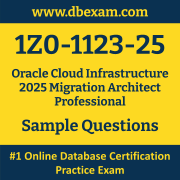01. What is the minimum bandwidth to be considered while connecting between an on-premises and Oracle Cloud Infrastructure?
a) 10 Gbps
b) 100 Gbps
c) 50 Gbps
d) 1 Gbps
02. Your organization is planning to migrate VMware-based workloads hosted in an on-premises environment to OCI Compute using Oracle Cloud Migrations (OCM). As a Cloud Migrations Architect, you are creating an "Asset Source" to discover workloads.
Which of the following TWO describes the purpose of an "Asset Source"?
a) Represents a virtual appliance deployed on-premises to discover workloads.
b) Credentials required for OCM to access on-premises systems.
c) Repository in OCI for temporarily storing migrated assets.
d) Discovery schedule that defines how often source workloads are discovered.
e) Third party tool for real-time cost analysis during migration planning.
03. After replicating Virtual Machine (VM) data to Oracle Cloud Infrastructure using the Oracle Cloud Migrations service, what is the next step to launch the migrated instance?
a) Generate a Resource Manager Stack to deploy the Compute instance with the replicated data.
b) The Hydration Agent serves as the migrated Compute instance.
c) Select the target asset in the OCM UI and initiate the boot process from the replicated data.
d) The Compute instance is automatically launched after the replication process.
04. Which of these tool can advise on the suitable method for migration of your source oracle database to target OCI database service?
(Select three)
a) Oracle Estate Explorer
b) Migration Methods Advisor
c) Service Advisor
d) Cloud Migration Advisor
e) Cloud premigration advisor tool (CPAT)
05. In Oracle Cloud Infrastructure (OCI) Full Stack Disaster Recovery service, where can we create a DR Plan execution?
a) Primary DR Protection Group
b) Standby DR Protection Group
c) Neither Primary nor Standby DR Protection Group
d) Both Primary and Standby DR Protection Group
06. What are the TWO components in a Migration Asset?
a) Create Migration Plan
b) Confirm Resource Manager Stack for the migrated VM
c) Select Inventory assets
d) Choose Replication location
07. Which of the following statements about Oracle Cloud Infrastructure (OCI) Bring Your Own IP (BYOIP) is correct?
a) BYOIP supports any CIDR block size for both IPv4 and IPv6.
b) BYOIP supports IPv6 CIDR blocks ranging from /24 to /8.
c) BYOIP only supports IPv4 CIDR blocks of exactly /24.
d) BYOIP supports IPv4 CIDR blocks ranging from /24 to /8.
08. You are part of the cloud architecture team in an organization and tasked with creating a Business Case to demonstrate the benefits of using Oracle Cloud VMware Solution (OCVS).
Which two of the following advantages should you highlight about migrating to OCVS?
a) The company can bring their own product licenses (BYOL) for VMware products such as vSphere, vSAN, and NSX.
b) The company can control root access of the OCVS environment.
c) Migrating to OCVS converts all VMware-based applications into native OCI Compute Instances.
d) The company can continue to leverage the team's existing VMware skill sets within OCI.
09. In which phase of migrating to Oracle Container Engine for Kubernetes (OKE) do tasks like deploying workloads using Oracle Cloud Infrastructure Registry, conducting comprehensive testing, and shifting traffic from the source environment to OKE take place?
a) Planning and Establishing a Foundation.
b) Evaluating and Identifying Your Workloads.
c) Implementing Your Workloads.
d) Optimizing Your Environment.
10. Which tools/utilities/features can support migration to autonomous database?
(Choose two.)
a) RMAN
b) SQL Developer
c) Data Pump
d) Unplug and plug database
 The Oracle Cloud Infrastructure Migration Architect Professional (1Z0-1123-25) Sample Question Set is designed to help you prepare for the Oracle Cloud Infrastructure 2025 Migration Architect Certified Professional certification exam. To become familiar with the actual Oracle Certification exam environment, we suggest you try our Sample Oracle 1Z0-1123-25 Certification Practice Exam.
The Oracle Cloud Infrastructure Migration Architect Professional (1Z0-1123-25) Sample Question Set is designed to help you prepare for the Oracle Cloud Infrastructure 2025 Migration Architect Certified Professional certification exam. To become familiar with the actual Oracle Certification exam environment, we suggest you try our Sample Oracle 1Z0-1123-25 Certification Practice Exam.